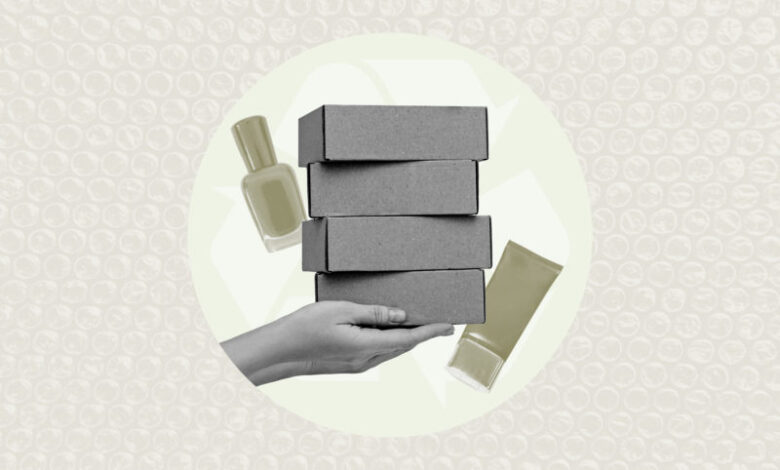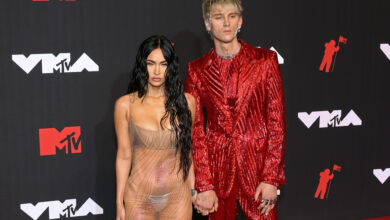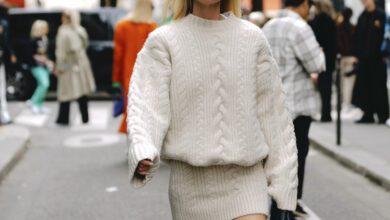Do Eco-Friendly Subscription Boxes Exist? We Investigate

[ad_1]
Subscription services may offer us a dopamine hit — and be necessary at times. But buying boxes full of things we don’t always need and having them shipped to our house leaves a long trail of damage. Here are ways to minimize the hit to the environment.
I was about to hit “place order” on a beauty subscription box when I was seized by a too-familiar feeling: guilt. I halted my shopping to think about why, and to examine the contents of the box.
It had glittery pink lettering and contained a few products I had been lusting after: hello, Bum Bum Cream! But upon closer inspection, I couldn’t deny that I didn’t actually need anything in the box. It contained mascara, which I already owned. The sample size lotion included enough product to cover my body approximately one-and-a-half times. There was a bright mini lipstick, a set of lashes. I’m pretty androgynous: if I’m really trying to impress, I’ll put on a little tinted face oil, add some rosy lip balm, and fill in my brows.
I came to my senses and closed my cart. I had clearly just been shopping to cover up a case of the sads. Shopping releases dopamine, and my brain needs all of the happiness-inducing hormones it can get right now, being cut off from loved ones and everything I usually look forward to. Still, I felt guilty that my purchase would likely just contribute to the heaps of waste already lying in landfills. But I also wondered if I was being extreme, knowing choices made at the individual level are hardly going to fix environmental woes or the beast that is late-stage capitalism.
When I relayed this story and my conflicting thoughts to Tim Gray, executive director of Environmental Defence, an environmental advocacy group, he laughed and said “Good decision!” Buying boxes full of things we don’t need and having them shipped to our house is easy, but it leaves a long trail of damage.
“Every time you get a box of stuff from that you didn’t need, there’s a whole chain of pollution impacts that start in your neighbourhood and go all the way back to the people that are involved in manufacturing it [often] on the other side of the world,” he says. Your stuff has to travel by truck, by plane or ship, then by another few trucks to reach you. It adds up.
In Canada in 2019, 25 percent of greenhouse gas emissions were from the transportation sector alone. And this was before everyone who could was having everything delivered, both out of convenience and by necessity (hello, pandemic). Not only do subscription box orders contribute to this, but what’s in them often ends up in the landfill: unloved products, foods the family doesn’t like. Then there’s the plastic packaging and the fact that less than only 10 percent of plastic ever gets recycled in Canada.
Of course, it’s also easy to make broad strokes criticisms about the harms these boxes can cause, especially when those ordering them don’t actually need the contents. It would be better for the environment to just go buy what you need from the store. Preferably local! Preferably organic! But this isn’t accessible to everyone, and applying judgment to subscribers overall creates unnecessary harm, especially these days. According to one survey of American subscribers by Coupon Follow, 20 percent of those ordering subscription boxes over the past year did so simply to have products available to them throughout the pandemic, and the most popular categories of the 3,500 or so boxes on the market were food and pet care. Even Gray says food is a clear exception to his critique.
Jewelles Smith, a communications coordinator with the Council of Canadians with Disabilities, thinks so too. She has a compromised immune system, and since the pandemic began, she’s been in a version of lockdown: it’s too risky for her to go out and potentially be exposed to the virus.
“It’s incredibly stressful to be out in public,” she says, with people flouting distancing protocol and reaching directly over her body at the store. “For me, delivery has been amazing.”
So she’s been ordering food from local farmers through Vancouver’s SPUD for the past year. Like many other subscription box companies, SPUD is working on sustainability: they deliver food in reusable bins, and plan their delivery routes to reduce emissions as much as possible. Other enviro-friendly subscription options include the Toronto-based Mama Earth Organics, who reuse their bins when they deliver local organic food, prepared meals and products, and 2Peonies, who deliver simple, elegant bouquets, reusing the same glassware with each delivery.
While food is an obvious exception, Smith cautions non-disabled people to hold their judgment regardless of what other people are ordering and why. People with disabilities may not be able to go out and browse for personal care products in the same way folks without disabilities can, and subscription boxes can fill in the gap. Also, she says, people with disabilities think often about how to mitigate waste, since they’re regularly managing disposal of bottles, EpiPens and other supplies that are essential for their health.
There are other reasons people may sign up, too. Chúk Odenigbo’s love of fashion stems from his connection to his culture, both as a Black man and a Francophone person. He’s also passionate about the environment: as founding director and director of ancestral services with Future Ancestors, a Black and Indigenous-owned, climate-focused research, advocacy and consulting organization, he cares deeply about sustainability. Managing these passions isn’t always easy, but Odenigbo does it with care.
“Being Black in Canadian society, we’re often dehumanized. And so fashion is often used as a tool by Black people to sort of regain their humanity and be seen as valuable human beings, which is why a lot of really interesting fashion trends happen to be Black,” he says. He’s done a lot of advocacy to eradicate the trope that, to be a true nature lover, one must adorn oneself in shapeless khakis only. This idea, he says, is unnecessarily restrictive, and creates divisions where none exist.
For Odenigbo, it’s a beautiful thing for men and boys to be able to order clothing via subscription boxes, because it helps them to explore their identity or presentation at home.
“What I love about subscription boxes is that they give people a safe space to decide if they’re going to change themselves,” he says. When we feel permission to explore and express our true selves, it can help us to feel more relaxed and able to open up emotionally, he explains, which in turn can lessen the hold of toxic masculinity on these boys and men.
Odenigbo suggests buying what you actually need, and shelling out for the best quality you can afford, even if it means saving up for a while. That way, whatever you buy has a better chance of being well-loved, and when you’re done with it, it’s likelier to see a second life outside of the landfill. He also stressed the importance of kinship, or making sure the brands you’re choosing have a harmonious relationship with the environment and workers. If people are paid properly, environmental harms are reduced as much as possible, and the items you’re ordering are getting used, the guilt becomes a pointless emotion. He advises those looking to do this to pay careful attention not just to whether a brand claims to be sustainable, but to how much information it offers up: where was the item made, of what materials, by whom, which practices were used?
Even makeup shouldn’t be labeled as frivolous. For some, especially queer and trans people, it can be crucial to identity and self-expression. And for low-income disabled folks — a too-high proportion of this population — freebie sampler or trial boxes may be necessary, too. “I think it’s kind of fun, and it gives people access to things that they otherwise wouldn’t have,” Smith says.
As for me, I’ll probably keep feeling guilty about these choices. But the next time I’m sick or stressed, you just might catch me carefully assembling a veggie linguine from a box.
[ad_2]
Source link






